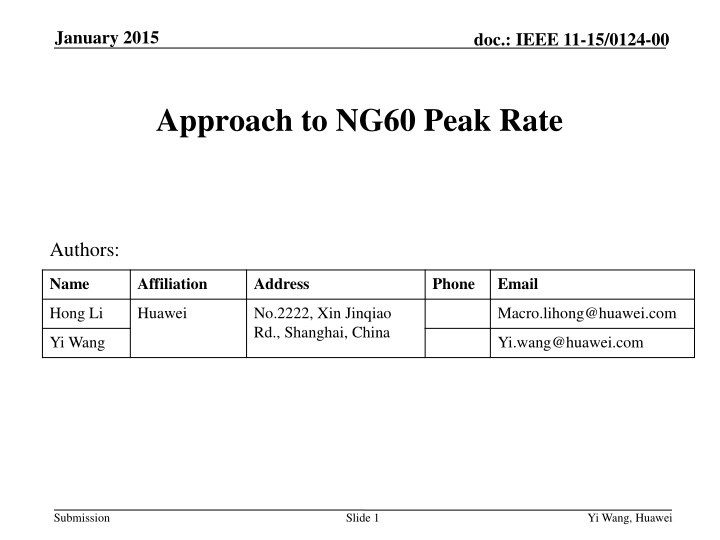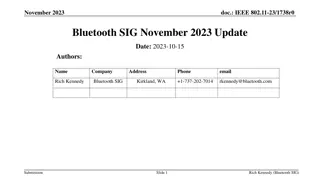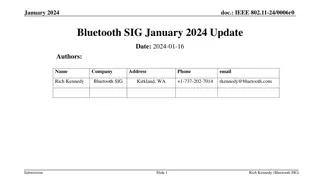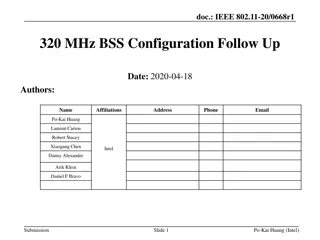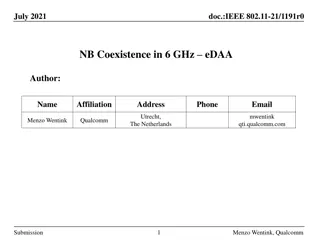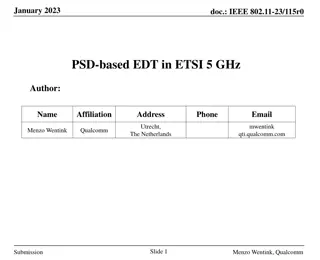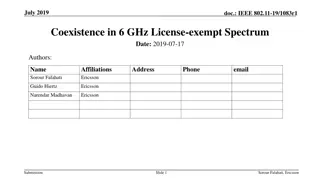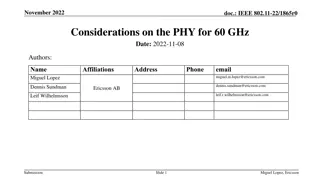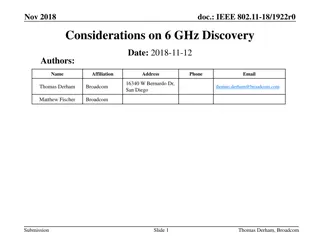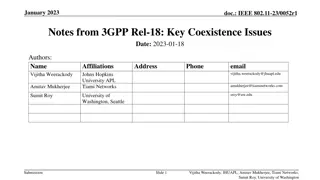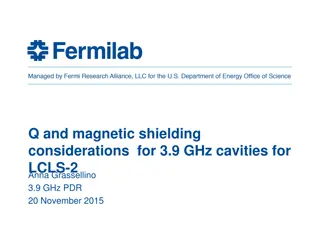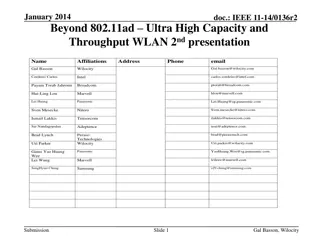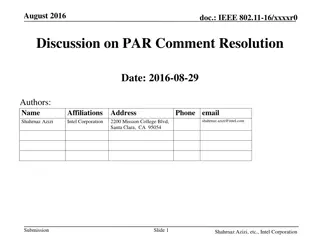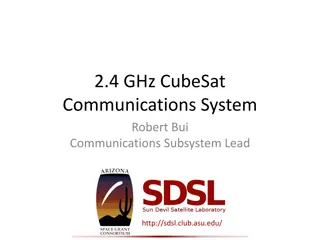Next-Generation 60 GHz Peak Data Rate Technologies
This presentation delves into the exploration of potential technologies to meet the peak data rate requirements of NG-60, focusing on enhancements to IEEE 802.11 physical and medium access control layers. Various channel bonding scenarios and achievable peak data rates are discussed, aiming to reach a target throughput of at least 20 gigabits per second while maximizing power efficiency. Considerations are made for IEEE 802.11ad parameters and MAC overhead to optimize data rate efficiency for NG-60. The utilization of multiple gigabit wireless systems around the 60 GHz frequency band is also examined.
Download Presentation

Please find below an Image/Link to download the presentation.
The content on the website is provided AS IS for your information and personal use only. It may not be sold, licensed, or shared on other websites without obtaining consent from the author.If you encounter any issues during the download, it is possible that the publisher has removed the file from their server.
You are allowed to download the files provided on this website for personal or commercial use, subject to the condition that they are used lawfully. All files are the property of their respective owners.
The content on the website is provided AS IS for your information and personal use only. It may not be sold, licensed, or shared on other websites without obtaining consent from the author.
E N D
Presentation Transcript
January 2015 doc.: IEEE 11-15/0124-00 Approach to NG60 Peak Rate Authors: Name Affiliation Address Phone Email Hong Li Huawei No.2222, Xin Jinqiao Rd., Shanghai, China Macro.lihong@huawei.com Yi Wang Yi.wang@huawei.com Submission Slide 1 Yi Wang, Huawei
October 2014 doc.: IEEE 11-15/0124-00 Abstract In this presentation we study what are the potential technologies to meet the peak data rate requirements defined in NG-60 PAR. Submission Slide 2 Yi Wang, Huawei
doc.: IEEE 11-15/0124-00 NG60 PAR This amendment defines standardized modifications to both the IEEE 802.11 physical layers (PHY) and the IEEE 802.11 medium access control layer (MAC) that enables at least one mode of operation capable of supporting a maximum throughput of at least 20 gigabits per second (measured at the MAC data service access point), while maintaining or improving the power efficiency per station. Submission 3 Yi Wang, Huawei
doc.: IEEE 11-15/0124-00 IEEE802.11 ad Parameters IEEE802.11 ad standard defined a point-to-point link that could reach peak data rate of 6.7Gbps (OFDM) by means of one single band with bandwidth of 2.16GHz. Submission 4 Yi Wang, Huawei
doc.: IEEE 11-15/0124-00 How to reach NG-60 data rate target Channel bonding: Aggregate more 11ad channels. [*] Suppose NG-60 uses other parameters as same as IEEE802.11ad. 802.11ad NG60 PHY Peak Data Rate (Gbps) Peak Rate 2 channels 3 channels 4 channels SC PHY 4.62 (12) [**] 9.24 13.86 18.48 Low Power SC PHY 2.5 (31) 5 7.5 10 OFDM PHY 6.76( 24) 13.52 20.28 27.04 ** MCS Scheme, SC PHY: LDPC, pi/2-16-QAM + code rate; Low Power SC PHY: LDPC, pi/2-QPSK 5/8 code rate; OFDM PHY: LDPC, 64-QAM, 13/16 code rate; NG-60 Peak rate = BW * SE per beam * Report ITU-R M.2227, Multiple Gigabit Wireless Systems in frequencies around 60 GHz , 2011 The nominal channel bandwidth of 11ad is 2.16 GHz. Four channels are defined for this band, but they are not universally available. The available band around 60 GHz(57 GHz to 66 GHz) is regulated differently in various regions of the world. Submission 5 Yi Wang, Huawei
doc.: IEEE 11-15/0124-00 How to reach NG-60 data rate target Considering the MAC overhead, the data rate of MAC will be smaller than that of PHY, suppose that the MAC efficiency of NG60 can reach 70% [*], thus the MAC data rate of different channel combinations are: NG60 MAC Peak Data Rate (Gbps) 2 channels 3 channels 4 channels SC MAC 6.47 9.7 12.94 Low Power SC MAC 3.5 5.25 7 OFDM MAC 9.46 14.2 18.93 thus the largest achievable Peak data rate of MAC is, 27.04*0.7 = 18.93Gbps, which is still lower than the target, 20Gbps. * 2014-TECH-Panasonic-0001-00-NG60 USR usage models.pptx Submission 6 Yi Wang, Huawei
doc.: IEEE 11-15/0124-00 How to reach NG-60 data rate target Multi-stream Increase stream up to 8 streams. Suppose NG-60 uses other parameters as same as IEEE802.11ad 802.11ad NG60 PHY Peak Data Rate (Gbps) Peak Rate 2 streams 4 streams 18.48 8 streams 36.96 9.24 SC PHY 4.62 (12) 5 10 20 Low Power SC PHY 2.5 (31) 27.04 54.08 13.52 OFDM PHY 6.76( 24) Similarly, suppose that the MAC efficiency of NG60 can reach 70%, the largest achievable MAC Peak data rate of 4 streams is, 27.04*0.7 = 18.93Gbps<20Gbps. When increasing the stream number up to 8, 20Gbps can be easily achieved. But the implementation of 8 streams is challenging because of the hardware complexity. MAC Peak Data Rate (Gbps) NG60 4 streams 2 streams 8 streams SC MAC 25.87 6.47 12.94 Low Power SC MAC 3.5 7 14 OFDM MAC 37.86 9.46 18.93 Submission 7 Yi Wang, Huawei
doc.: IEEE 11-15/0124-00 How to reach NG-60 data rate target Channel bonding + Multi-stream 802.11ad NG60 PHY Peak Data Rate (Gbps) 2 streams 4 streams Peak Rate 2 channels 3 channels 2 channels SC PHY 4.62 (12) 18.48 27.72 36.96 Low Power SC PHY 2.5 (31) 10 15 20 OFDM PHY 6.76( 24) 40.56 54.08 27.04 Suppose that the MAC efficiency of NG60 can reach 70%, the 20Gbps MAC data rate can be achieved by: 2 streams with aggregation of 3 channels or even more. 4 streams with aggregation of 2 channels or even more. NG60 MAC Peak Data Rate (Gbps) 2 streams 4 streams 2 channels 3 channels 2 channels 12.94 19.4 25.87 SC MAC 7 10.5 14 Low Power SC MAC 28.39 37.86 18.93 OFDM MAC Submission 8 Yi Wang, Huawei
doc.: IEEE 11-15/0124-00 Summary Suppose that the MAC efficiency of NG60 can reach 70%: The target data rate of NG60, 20Gbps, can NOT be achieved by means of simply extending bandwidth based on 11ad (at most 4 channels). The target data rate of NG60, 20Gbps, could be achieved by means of simply increasing streams based on 11ad up to 8 streams. But the implementation of 8 streams is challenging. The target data rate of NG60, 20Gbps, could be achieved by combining Channel bonding and MIMO. 2 streams with 3 channels or even more bandwidth 4 streams with 2 channels or even more bandwidth Submission 9 Yi Wang, Huawei
